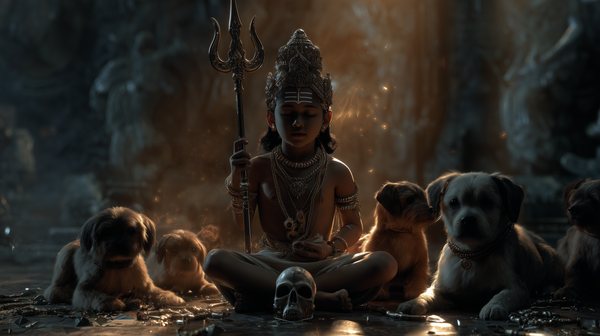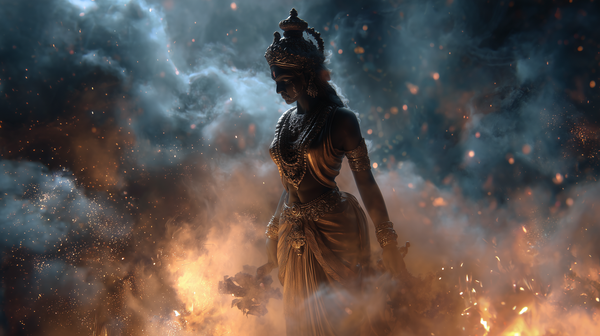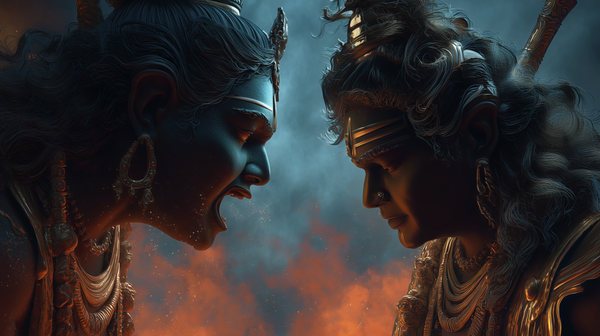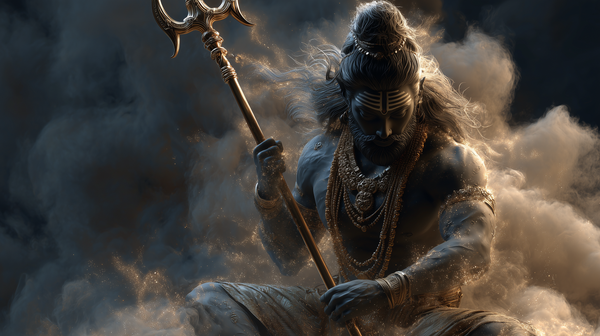BHAIRAVA SADHANA - FAMILY, DESIRES, KARMA AND the JIVA
Those who progress significantly in Bhairava sadhana are rarely in their first human birth - they carry complex karmic imprints and deeply embedded desires from multiple incarnations that must be recognized and released

This article is derived from Guruji’s video lecture, Satsang, Praveen Radhakrishnan. All content and intellectual property rights belong to Guruji and the KaliPutra Mission
Introduction: The Path of Previous Births
[00:00:08] Those who progress significantly in Bhairava sadhana are rarely in their first human birth. Unlike the common progression from pashu yoni (animal form) to manushya yoni (human form), advanced practitioners have typically experienced multiple human incarnations. An exception exists for bali animals (sacrificial offerings) presented to Bhairava on specific tithis, who may receive immediate elevation to human or celestial births.
[00:01:09] These multiple births create complex karmic imprints. Practitioners carry not just accumulated karma but also deeply embedded desires and soul impressions from having lived as both men and women across various lifetimes. These imprints remain indistinguishable from current life experiences, creating unconscious drives that can significantly impact spiritual progress.
Latent Memories and Unexplained Desires
[00:02:01] The speaker illustrates this concept through a poignant example: imagine someone who was a celebrated dancer in a previous life, receiving standing ovations and adoration. Now reborn as a laborer living in a humble dwelling, they experience an inexplicable urge to dance despite having no opportunity or encouragement in their current circumstances. Their supervisor would likely reprimand them for dancing instead of working, yet the desire persists.
[00:02:50] These latent memories manifest as persistent urges without logical explanation in one's current life context. A person might dream constantly of performing on stage, being a military officer, or achieving athletic greatness - never taking concrete steps toward these goals, yet unable to release the fantasies. For those not on a sadhana path, an entire lifetime can pass chasing these shadows unsuccessfully, constrained by practical limitations of work, family obligations, and financial responsibilities.
The Trap of Past-Life Desires in Spiritual Practice
[00:04:25] Understanding these desires as remnants from previous births becomes crucial in Bhairava sadhana, where the ultimate goal is moksha (liberation). The practitioner must recognize that Bhairava cannot simply grant liberation to someone who performs hundreds of malas daily while internally yearning to relive past glories. These desires represent a fundamental obstacle to spiritual progress.
[00:05:15] As sadhana deepens, the ego (one's name, address, personal identity) and the jiva (soul) begin merging rapidly. While this integration makes picking up new desires unlikely, pre-existing desires from before spiritual initiation pose significant challenges. The practitioner must reach a decisive point of renunciation, firmly declaring: "I no longer want that." This isn't mere suppression but genuine release, recognizing these desires as traps leading to rebirth.
The Cycle of Material Fulfillment and Spiritual Amnesia
[00:06:47] The speaker describes a common spiritual trap: imagine someone who lived in poverty in one life, desperately praying to deities for wealth. In the next birth, they receive everything - massive bungalows, luxury cars, servants. However, upon achieving material success, they forget their spiritual path entirely. The deity then "plucks" them from comfort, resulting in a simpler rebirth where past-life memories of luxury persist as tormenting desires.
[00:07:32] This creates a vicious cycle. If practitioners on the moksha path still harbor desires for their previous extraordinary lives, Bhairava might grant "one more great life" instead of liberation. The speaker poses a sobering question: do you truly want to return to physical existence in 2250 CE, described as a dystopian future of extreme pollution, five-hour traffic jams, and oppressive micromanagement where "even each breath will be taxed"?
Moksha: The Ultimate Goal Beyond Material Success
[00:08:56] The speaker emphasizes unequivocally: "The ultimate goal of Bhairava path is moksha. It is not to live extraordinarily or to gain material wealth." While Bhairava sadhana can be used for material prosperity, achieving this in a deteriorating future world where people desperately seek to escape Earth itself represents a hollow victory. The true plan should be to never return.
[00:09:56] A sign of genuine progress appears when pre-sadhana desires begin to ebb naturally. Practitioners must clearly communicate to Bhairava: "I have none of those desires. My desire is Oneness. I want to achieve you and to be one of you, part of you, out of the physical existence." Those making extraordinary progress while still harboring past-life desires will inevitably face rebirth to fulfill them.
Understanding Soul Age Through Desires
[00:10:47] The speaker distinguishes between souls based on their desires and reactions to life. Very young souls (one or two human births) exhibit animalistic tendencies, particularly in pursuing bodily pleasures, food, or relationships. They haven't yet recovered from animal instincts - unlike animals that mate only in season, humans should reproduce only from necessity, with urges naturally subsiding afterward.
[00:11:35] Those who cannot control such desires risk regression to animal forms for brief lifespans before returning as humans. The speaker warns that any excess represents danger - whether an insatiable quest for new culinary experiences, constant pursuit of new partners, or other uncontrolled cravings. These patterns indicate that the current birth may not be one's final incarnation.
Karma Acceleration Through Painful Experiences
[00:16:08] The second major theme addresses the "empty garbhagriha" (sanctum) within the jiva. The speaker shares a profound real-life story: meeting someone whose special needs child passed away before age seven after prolonged suffering. This man, a sadhana practitioner who had desired a child while seeking oneness with Shiva, received this painful experience as accelerated karma burning.
[00:18:43] Through this tragedy, the practitioner burned karma meant for another entire lifetime within just five years. The child's suffering transformed him - he no longer fears death and has completely released any desire for children. This illustrates how the path of Shiva or Shakti involves burning significant karma, with certain experiences occurring specifically to eliminate lingering desires.
The Divine Design of Difficult Relationships
[00:21:59] A crucial insight: "Nobody with a perfect life is fit for spiritual path." Those with many past births are deliberately born into "complete procedural collapse" with specific pain points preventing them from becoming too comfortable in physical existence. Unlike new souls who find happiness in promotions, vacations, or children's achievements, advanced souls face strategic challenges.
[00:23:35] If you lack a supportive father, mother, spouse, or have difficult children, understand this as divine design. Within your jiva exists an empty garbhagriha where you must place the deity, invoking them with full bhakti as your true father, mother, spouse, or child. When family members seem blind to your obvious suffering, recognize this as intentional spiritual architecture.
Navigating Relationships Without Creating New Karma
[00:24:27] The practical approach to difficult relationships requires careful balance. Physically, remain genuine and cordial to avoid incurring fresh karma - be respectful to a terrible father, render basic service without fighting. Internally, the jiva must continuously communicate to the ego why these specific relationships exist in your life. They serve to prevent excessive comfort that would distract from the spiritual path.
[00:25:14] Understanding this design transforms perspective. That terrible father? The deity IS your father, manifesting through this person who must burn their own karma. Maintain civility while recognizing the deeper spiritual dynamics. Tell Bhairava: "I know what you're doing. I know you know that I know. So please remove these obstacles."
The Cliff Metaphor: Complete Surrender
[00:28:33] Bhairava sadhana resembles jumping off a cliff. While falling, you'll see branches and trees, but you must resist grabbing them. This represents complete surrender and trust. Once you've recognized latent memories, placed the deity in relationship voids, and renounced rebirth for past desires, you must simply let go and trust the fall.
[00:29:45] When difficulties arise in office or life, don't complain to humans - go directly to Bhairava and cry your heart out. Problems will vanish without physical confrontation. Enemies lose focus, forgetting why they wanted to harm you. Stones in your path break by themselves. This isn't about passivity but about operating from a higher spiritual mechanism.
Practical Summary for Practitioners
[00:31:17] Three key principles emerge:
- Any unfulfillable desire in this birth represents a latent memory from previous births - recognize this truth rather than mistaking it for a current life goal.
- Place the deity in every broken relationship - understanding that in Bhairava sadhana for moksha, you won't have perfect key relationships. This design ensures you don't get too comfortable in physical existence.
- Avoid physical reactions to external problems - communicate with Bhairava about obstacles rather than fighting them directly. Maintain civility to avoid creating new karma while trusting divine intervention.
Beyond Books and Temples
[00:34:34] The speaker emphasizes receiving direct transmission from Bhairava rather than reading spiritual books: "Bhairava is a very, very, very talkative Guru. He loves to talk with you." Even more communicative is Adishakti Mahakali. The path transcends temples and texts - sometimes you must raise your head from books to see the deity standing before you.
[00:37:24] Messages appear in trees, leaves, and sudden life events. Procedural collapse itself represents Bhairava's path - everything collapses "so that you realize." When facing terrible relationships, understand the divine thread, remain calm, avoid accumulating hatred, and recognize these as opportunities for realization rather than sources of new karma.
Final Wisdom
[00:38:39] Stop trying to control your life. Recognize you've completed many human births carrying numerous desires that must be uprooted. Tell Bhairava: "I will not fall for your trick again. I understood this is from past births. I have already attained it. Remove it from my life."
Bhairava sadhana isn't about mantras or yantras alone - it's about you. Life will unfold naturally when you understand these principles, maintain proper conduct to avoid new karma, and trust completely in divine guidance. The path requires recognizing the spiritual design in life's difficulties and surrendering to the process of liberation rather than grasping for control or past glories.
Glossary
- Bhairava Sadhana: A spiritual practice or path dedicated to the deity Bhairava, often associated with Shiva.
- Pashu Yoni: An animal birth or existence (contrasted with Human or Celestial births).
- Manisha Yoni: A human birth or existence.
- Titi: A specific lunar day or phase, often considered auspicious for certain rituals.
- Viddhi: A rule, procedure, or decree (in this context, referring to spiritual principles or laws).
- Jiva: The individual soul or consciousness, which carries karma, desires, and imprints across lifetimes.
- Karma: Action, effect, or consequence, shaping one's experiences in current and future lives.
- Residual Karma: Karma accumulated from previous births that is still active and influencing the current life.
- Maya: Illusion or the illusory nature of the material world.
- Moka: Liberation from the cycle of birth, death, and rebirth; ultimate spiritual freedom.
- Sadhana: Spiritual practice or discipline undertaken to achieve a particular spiritual goal.
- Diety: A god or goddess; a divine being that is the focus of worship or spiritual practice.
- Ego: The sense of individual self, separate from the universal consciousness; encompasses one's name, identity, passions, etc.
- Malas: Rosary beads used for counting repetitions of mantras during meditation or prayer.
- Latent Memories: Hidden or dormant memories from past experiences or births, residing within the Jiva.
- Yuga: An epoch or era in Hindu cosmology (Kaliyuga is the current age, often described as a time of decline and difficulty).
- Gagha (likely referring to Ga'ah): A space or void within the Jiva where the deity can be placed or invoked (this term appears unique to the speaker's usage in this context).
- Bhakti: Devotion or intense love for the deity.
- Ahamkara (not explicitly used but related to Ego): The sense of "I-ness" or self-identity.
- Adishakti Ma Kali: The primordial divine feminine energy, a fierce form of the Goddess Kali, described as very talkative by the speaker.
- Nimitta: An omen, sign, or synchronicity.




